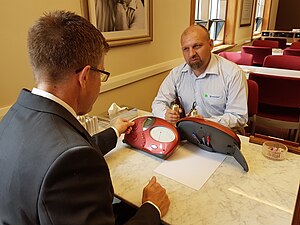
Back Одитинг (сциентология) Bulgarian Auditing (Scientology) Italian オーディティング Japanese Auditeren (Scientology) Dutch Одитинг Russian Audit (Scientology) SIMPLE Auditör (scientologi) Swedish 聽析 Chinese

| Part of a series on |
| Scientology |
|---|
 |
| Controversies |
|
| More |
Auditing, also known as processing, is the core practice of Scientology. Scientologists believe that the role of auditing is to improve a person's abilities and to reduce or eliminate their neuroses. The Scientologist is asked questions about past events while holding two tin cans attached to an electrical resistance meter (galvanometer) with a dial.[7] The term "auditing" was coined by L. Ron Hubbard in his 1950 book Dianetics: The Modern Science of Mental Health, which describes the process.[8]: 28 Auditing uses techniques from hypnosis that are intended to create dependency and obedience in the subject.[9]
The auditing process involves repeated questioning forming an extended series. It may take several questions to complete a process, several processes together are a rundown, several rundowns completed and the Scientologist is deemed to have advanced another level on the Bridge to Total Freedom. The Scientologist believes that completing all the levels on the Bridge will return him to his native spiritual state, free of the encumbrances of the physical universe.[10][11]: 81
The electrical device, termed an E-meter, is an integral part of auditing procedure, and Hubbard made numerous unsupported claims of health benefits. The Food and Drug Administration prosecuted Hubbard for practicing medicine without a license. Since 1971, Scientology now publishes disclaimers in its books and publications declaring that the E-Meter "by itself does nothing", and that it is used specifically for spiritual purposes, not for mental or physical health.[4][3]
- ^ Cite error: The named reference
Ar06was invoked but never defined (see the help page). - ^ Cite error: The named reference
Swe15was invoked but never defined (see the help page). - ^ a b United States of America, Libelant, v. Founding Church of Scientology et al., Claimants, D.C. 1–63 333 F. Supp. 357 (United States District Court, D.C. July 30, 1971) ("The E-meter is essentially a simple galvanometer using two tin cans as electrodes. It is crude, battery-powered, and designed to measure electrical skin resistance...A person using the meter for treatment holds the tin cans in his hands during an interview with the operator who is known as an auditor").
- ^ a b Cite error: The named reference
www-2.cs.cmu.eduwas invoked but never defined (see the help page). - ^ Cite error: The named reference
IntroEMwas invoked but never defined (see the help page). - ^ Cite error: The named reference
Mi87bwas invoked but never defined (see the help page). - ^ [1][2][3][4][5][6]
- ^ Cite error: The named reference
hubbard-techdictwas invoked but never defined (see the help page). - ^ Cite error: The named reference
HaSc24was invoked but never defined (see the help page). - ^ Cite error: The named reference
penthousewas invoked but never defined (see the help page). - ^ Cite error: The named reference
urbanwas invoked but never defined (see the help page).
© MMXXIII Rich X Search. We shall prevail. All rights reserved. Rich X Search